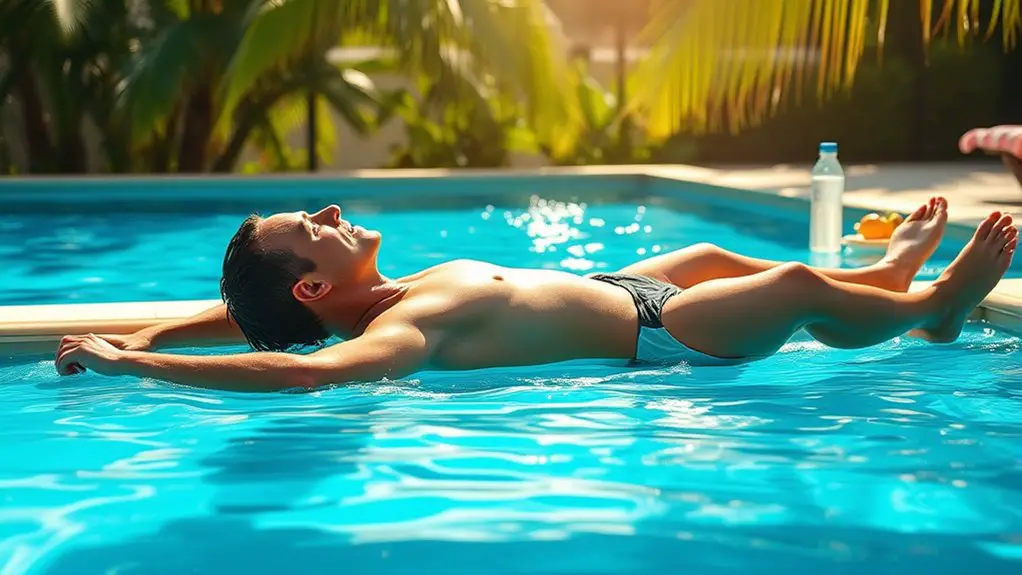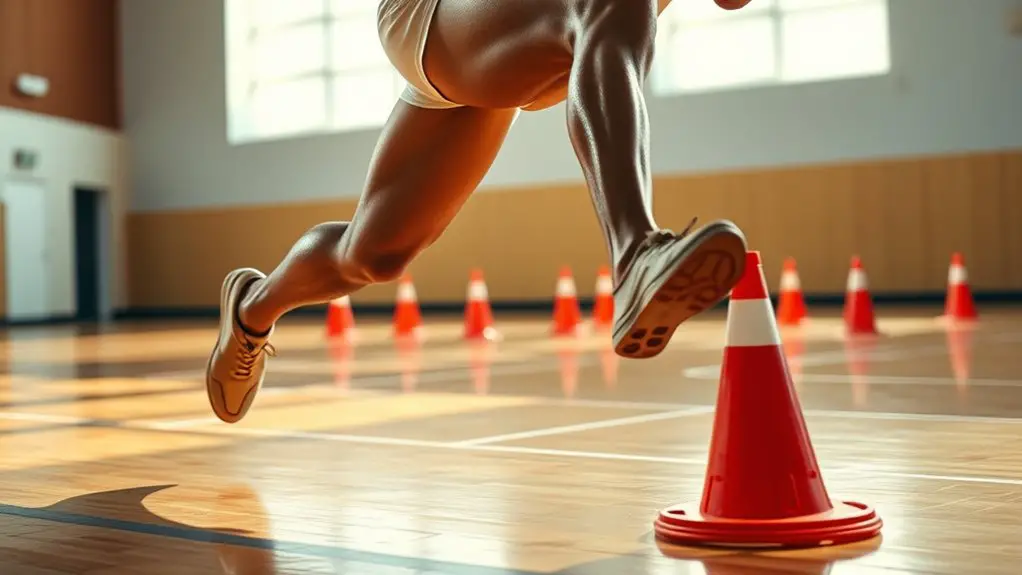To recover faster from intense swim sets, prioritize nutrition by fueling up with carbs before swimming and protein afterward. Stay hydrated before, during, and after your workouts to replenish fluids. Incorporate effective stretching and active recovery techniques like light swimming or foam rolling to alleviate soreness. Don't underestimate the importance of quality sleep, as it's key for muscle recovery. Explore mental recovery techniques and contrast therapy for added benefits, and you'll discover even more strategies to enhance your recovery.
Importance of Recovery in Swimming
Recovery is essential for maximizing your performance in swimming. After intense swim training, your body needs time to repair and rebuild. By incorporating effective recovery protocols, you're not just resting; you're strategically preparing for your next session. This freedom to recover allows you to swim stronger and faster, pushing your limits without risking burnout or injury.
Think about it: every time you hit the water, you're challenging your muscles and cardiovascular system. Without proper recovery, you're stifling your growth and potential. Active recovery techniques, like light swimming or stretching, can help flush out lactic acid and improve circulation, ensuring you feel fresh for your next workout. Additionally, engaging in proper cool down techniques post-swim helps transition your body into a restful state.
Embracing recovery means you're respecting your body's needs and maximizing your performance. So, listen to those signals, integrate recovery protocols into your routine, and watch how it transforms your swim training experience. You deserve to be at your best in the water!
Optimal Nutrition for Swimmers
When it comes to optimizing your swim performance, nutrition plays a key role. You need to make smart pre-swim fuel choices to guarantee you have the energy to push through your sets, and post-workout recovery snacks can greatly aid your recovery. To support your recovery, prioritize adequate protein intake after your workouts to help repair and rebuild your muscles. Let's explore what to eat before and after your swims for the best results.
Pre-Swim Fuel Choices
Fueling your body correctly before a swim can make all the difference in your performance and recovery. To maximize your energy, focus on pre-workout carbohydrates, like bananas or oatmeal, that provide sustained fuel. These carbs will keep you energized throughout your sets, allowing you to push your limits. Don't forget about protein timing; consuming a small amount of protein before your swim can help with muscle repair and readiness. Think Greek yogurt or a protein shake, but keep it light. Timing is key—aim to eat about 30-60 minutes before you hit the pool. With the right pre-swim fuel choices, you'll feel free to release your potential and swim like never before!
Post-Workout Recovery Snacks
After pushing your limits in the pool, what you eat next plays a significant role in how quickly you'll bounce back. To recover effectively, focus on protein-rich options that help repair those muscles you just worked hard. Think Greek yogurt, cottage cheese, or a protein shake. Pair these with carbohydrate sources like whole-grain toast, bananas, or a smoothie to replenish your energy stores. This combo not only fuels recovery but also keeps you feeling free and energized for your next session. Don't forget to hydrate, too; water or an electrolyte drink can enhance recovery. So grab your favorite snacks and enjoy the freedom of nourishing your body after a killer swim workout!
Hydration Strategies for Enhanced Recovery
While you might focus on your training intensity, hydration plays an indispensable role in your recovery process. To really maximize your gains, pay attention to hydration timing. Aim to drink water or electrolyte-rich fluids before, during, and after your swim sets. This keeps your body in peak condition, preventing fatigue and cramping.
Balancing electrolytes is also vital. After intense workouts, you lose essential minerals through sweat, so replenishing them helps restore your body's natural balance. Consider sports drinks or electrolyte tablets, especially if you're swimming in hot conditions.
Don't wait until you're thirsty; make hydration a regular part of your routine. Carry a water bottle wherever you go, and set reminders if needed. Understanding your fluid needs is crucial, as it helps you tailor your hydration strategy to fit your individual requirements. With these strategies, you'll not only recover faster but feel more energized and ready for your next swim session. Embrace the freedom that comes with ideal hydration!
Effective Stretching Techniques
When it comes to recovery, effective stretching techniques can make a big difference. You should incorporate dynamic stretching routines to prepare your muscles before swimming, and static stretching afterward to enhance flexibility. Focusing on targeted muscle groups will help you recover faster and reduce soreness. Incorporating post-workout stretches into your routine is essential for muscle recovery and overall performance.
Dynamic Stretching Routines
Dynamic stretching routines can greatly enhance your recovery from swim sets, as they prepare your muscles for the demands of the water. Incorporating dynamic warm-ups and flexibility exercises into your routine is simple and effective. Here are some key movements to include:
- Arm Circles: Loosen up your shoulders and improve range of motion.
- Leg Swings: Increase hip flexibility and engage your lower body.
- Torso Twists: Activate your core and enhance spinal mobility.
- High Knees: Elevate your heart rate while stretching your hip flexors.
These dynamic stretches not only boost your flexibility but also help you feel free and ready to tackle your swim sets with energy and confidence.
Static Stretching Benefits
Static stretching plays an essential role in recovery, especially after intense swim sets, as it helps to lengthen muscles and improve flexibility. By incorporating effective static stretching techniques into your routine, you can experience numerous benefits. You'll not only enhance your range of motion but also reduce muscle tension, which can lead to a quicker recovery. Stretching post-workout allows your body to unwind, promoting relaxation and reducing the risk of injury. The benefits of flexibility extend beyond just improved performance; they can enhance your overall well-being and give you a sense of freedom in movement. So next time you finish a challenging swim set, take a moment to enjoy the rejuvenating effects of static stretching. Your body will thank you!
Targeted Muscle Groups
Many swimmers overlook the importance of targeting specific muscle groups during stretching, but it can make a significant difference in recovery. Focusing on these areas helps alleviate muscle fatigue and enhances flexibility, which is essential post-strength training. Here are four effective stretching techniques you should incorporate:
- Shoulder Stretch: Release tension from those hardworking shoulder muscles.
- Hip Flexor Stretch: Open up your hips to improve stroke efficiency.
- Calf Stretch: Prevent cramping and maintain strong kicks.
- Chest Opener: Counterbalance the forward motion of swimming.
The Role of Sleep in Recovery
While you might focus heavily on your training regimen, it's essential not to overlook the role of sleep in your recovery. Quality sleep is your body's natural way of repairing itself, and it directly impacts your performance. Aim for ideal sleep duration, allowing your body to complete multiple REM cycles, which are vital for muscle recovery and memory consolidation.
Creating a conducive sleep environment can greatly enhance your sleep quality; think cool, dark, and quiet. Also, don't underestimate the napping benefits—short naps can recharge you and improve your focus during workouts.
Pay attention to your circadian rhythms; they regulate your sleep-wake cycle and influence how well you recover. By prioritizing sleep, you're not just resting; you're actively enhancing your recovery, so you can swim stronger and longer. Embrace the freedom that comes with a well-rested body and mind! Moreover, quality sleep reduces inflammation, which is crucial for maintaining strength and endurance during intense swim sets.
Active Recovery Methods
As you finish a tough swim set, incorporating active recovery methods can greatly enhance your overall recovery process. These recovery techniques can help you feel fresher and more energized for your next training session. Here are four effective active recovery methods to take into account:
- Light Swimming: A few easy laps at a relaxed pace can help flush out lactic acid and promote circulation.
- Dynamic Stretching: Engaging in gentle dynamic stretches keeps your muscles flexible and reduces soreness.
- Walking or Jogging: A brisk walk or light jog can stimulate your muscles without putting too much strain on them.
- Yoga or Mobility Work: Incorporating yoga poses can enhance flexibility and contribute to mental relaxation. Additionally, consider incorporating foam rolling techniques to further enhance muscle recovery and relieve tension.
Incorporating Foam Rolling
In addition to active recovery methods, incorporating foam rolling can greatly aid your recovery after swim sets. This simple yet effective practice helps target tight muscles and promotes muscle release, letting you feel more relaxed and ready for your next session. Start with some basic foam rolling techniques, focusing on areas like your calves, quads, and shoulders—the muscles that take a beating during intense swims.
Roll slowly over each muscle group for about 30 seconds, pausing on any tight spots to really break down tension. You'll find that this not only speeds up your recovery but also enhances your overall flexibility. The beauty of foam rolling is that it gives you the freedom to tune into your body's needs, allowing you to customize your recovery routine. Additionally, foam rolling can increase blood flow to your muscles, thereby enhancing the natural recovery mechanisms your body employs. So grab a foam roller, and let it work its magic on your sore muscles, ensuring you're back in the pool feeling fresh and rejuvenated.
Benefits of Contrast Therapy
Contrast therapy, which involves alternating between hot and cold water immersion, can greatly enhance your recovery after swim sets. By incorporating contrast therapy methods into your routine, you can experience a range of benefits that help you feel more energized and free in the water. Here are four key advantages:
- Reduced Muscle Soreness: Cold exposure helps constrict blood vessels, minimizing inflammation and soreness post-workout.
- Improved Circulation: Alternating temperatures boosts blood flow, delivering nutrients to your muscles for faster recovery.
- Enhanced Flexibility: The heat relaxes muscles, while the cold helps to reduce stiffness, allowing for greater range of motion.
- Mental Refresh: The invigorating experience of temperature changes can lift your spirits and sharpen focus, perfect for your next training session.
Additionally, incorporating proper nutrition strategies into your post-swim routine can further enhance your recovery process. Give contrast therapy a try, and you'll likely discover a newfound sense of freedom in your swimming!
Mental Recovery Techniques
Recovering from swim sets isn't just about physical techniques; mental recovery is equally important. To truly release your potential, you need to incorporate mental strategies that complement your training. Start using visualization techniques to imagine yourself gliding effortlessly through the water, feeling strong and in control. Picture each stroke perfectly executed, and let that positive energy flow into your recovery.
Mindfulness practices can also play a significant role in your mental recovery. Take a few minutes to focus on your breath, letting go of any stress or tension. This helps clear your mind and promotes relaxation, allowing your body to recover more effectively. Embrace the freedom that comes from a calm, centered mindset. By integrating these mental strategies, you'll not only speed up your recovery but also enhance your overall performance in the pool. Remember, a strong mind is just as important as a strong body. Additionally, incorporating positive self-talk can further empower your mindset and boost your confidence during the recovery process.
Frequently Asked Questions
How Long Should I Rest Between Intense Swim Sets?
Think of your body as a finely-tuned machine; without the right fuel and rest, it just won't run smoothly. When it comes to rest duration between intense swim sets, aim for 30 seconds to 2 minutes. This time helps maximize recovery benefits, allowing your muscles to replenish energy and reduce fatigue. You'll feel more energized and ready to dive back in, so don't rush it—embrace the freedom of recovery!
What Are Common Signs of Overtraining in Swimmers?
When you're pushing hard in the pool, it's essential to recognize the signs of overtraining. You might experience swimming fatigue, where every stroke feels heavier. Training burnout can creep in too, leaving you feeling mentally drained and unmotivated. If you notice persistent soreness, decreased performance, or disrupted sleep, it's time to listen to your body. Taking a step back can help you regain that freedom and joy in your swimming journey.
Can I Use Heat Therapy After Swimming?
Yes, you can definitely use heat therapy after swimming! Applying heat can promote muscle relaxation, easing tension and soreness. It's a great way to unwind and let your body recover. Just be cautious not to use heat on any swelling or acute injuries. A warm shower or a heating pad can do wonders, helping you feel free and rejuvenated after those intense swim sessions. Enjoy the soothing benefits of heat therapy!
How Does Age Affect Recovery From Swim Sets?
As the saying goes, "With age comes wisdom." However, age-related differences can impact your recovery strategies after swim sets. Younger swimmers may bounce back quicker due to more resilient muscles and faster metabolic rates. As you get older, it's essential to adapt your recovery methods—consider incorporating more rest, nutrition, and gentle stretching into your routine. Embracing these changes can help you maintain your freedom in the water and enjoy your swim journey longer.
Should I Avoid Swimming Completely During Recovery?
You don't have to avoid swimming completely during recovery. Instead, consider incorporating active recovery methods that keep you moving without overexerting yourself. Swimming alternatives, like light water jogging or gentle laps, can help maintain your fitness level while allowing your body to heal. Listen to your body, and don't hesitate to mix in some dryland exercises or cross-training activities to keep things fresh and enjoyable during your recovery period.




